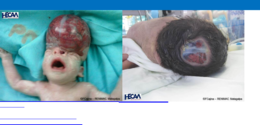Acalvaria or acalota is a rare malformation characterized by the absence of the scalp and some of the flat bones of the cranial vault. The size of the affected area is variable. In very rare cases the acalota can affect the entire upper part of the cranial vault, including the frontal, parietal and occipital bones. The dura mater and associated muscles are also absent in the affected area, however the central nervous system is usually not affected, although various neuropathological abnormalities are often present (eg, holoprosencephaly or abnormalities in the brain turns). The bones at the base of the skull and face are normal.

Prevalence
The prevalence is less than 1 in 100,000 births. Acalota is considered a post-neurulation defect. It is believed that the pathogenesis in the acalota originates from a failure in the migration of the desmocranium with a correct positioning of the embryonic ectoderm. This causes the absence of the shell, with the presence of a layer of skin intact over the brain parenchyma. This malformation is usually fatal at birth, although several cases of surviving children have been reported. Prenatal diagnosis is made by ultrasound and is usually confirmed by magnetic resonance imaging to distinguish between cases of anencephaly or encephalocele. The phenotypic description of this disease is based on an analysis of the biomedical literature and uses the terms of the Human Phenotype Ontology (HPO). Phenotypic abnormalities are presented in order of frequency of occurrence in the patient population, and in alphabetical order within each group of frequencies.
Diagnosis
Acalvaria must be distinguished from anencephaly , the most common differential diagnosis, by the presence of a layer of skin that covers the brain and normal cerebral hemispheres. This malformation is very often fatal at birth due to other associated abnormalities or trauma during delivery, but some infants who survived have been reported. Prenatal diagnosis through transvaginal ultrasound and / or MRI is essential for better management of the pregnancy .
Treatment
Initial treatment is conservative, mainly aimed at supportive measures and management of all associated anomalies, if present. Infants with acalvaria are managed conservatively in the neonatal period because spontaneous bone growth has been seen in some newborns with other skull abnormalities , such as congenital aplasia cutis . Reconstruction of the skull with bone graft and cranioplasty at school age has been discussed in the literature.
